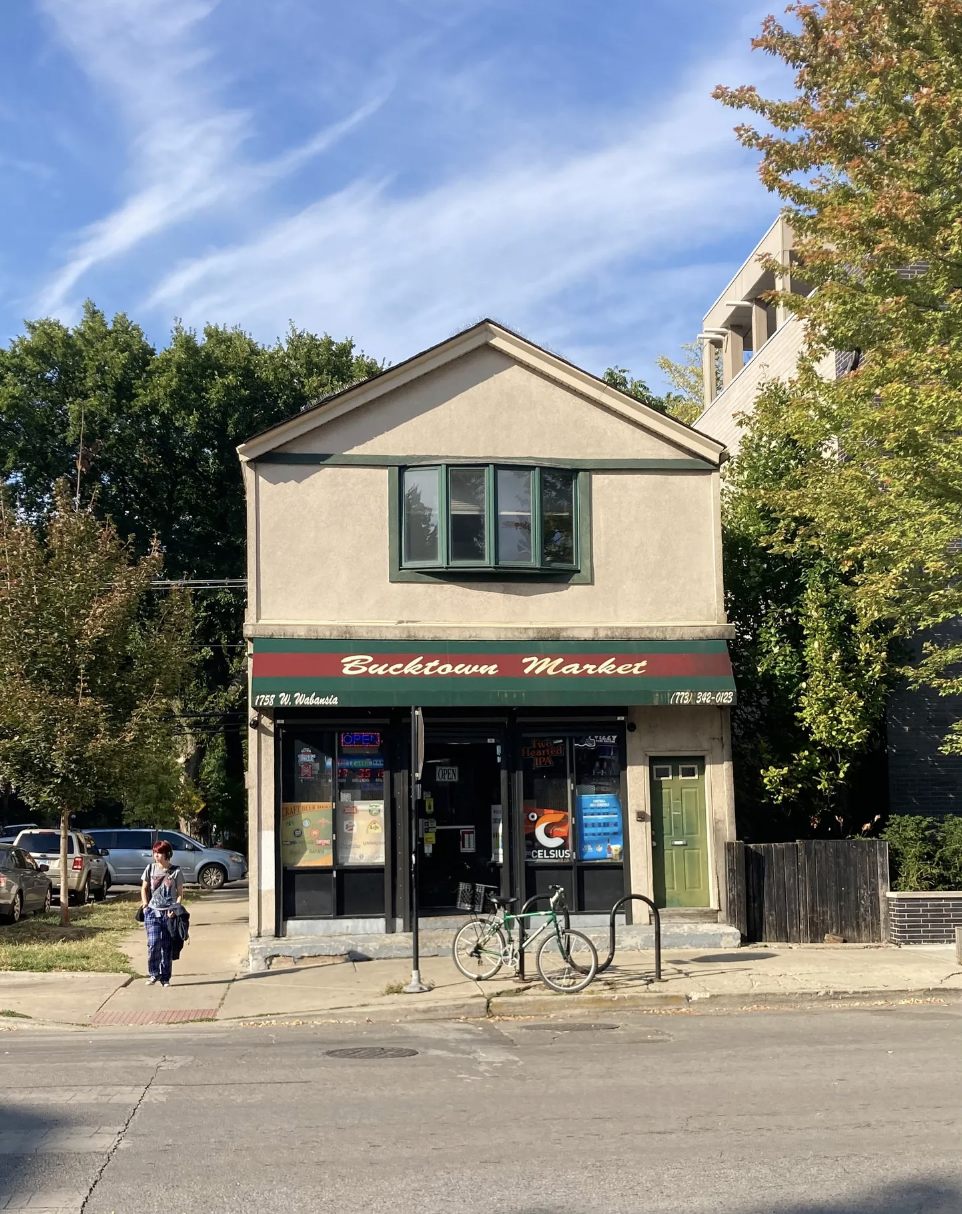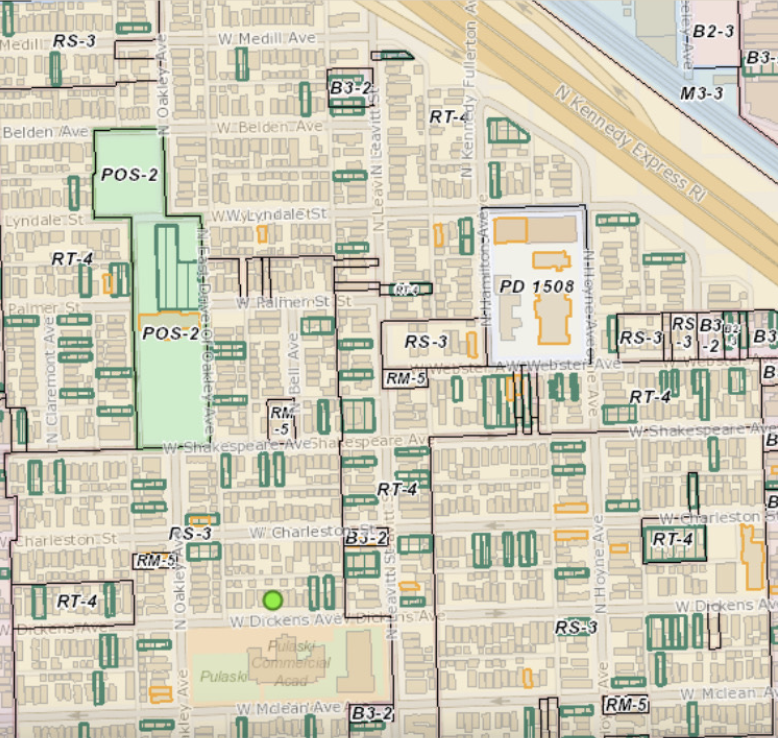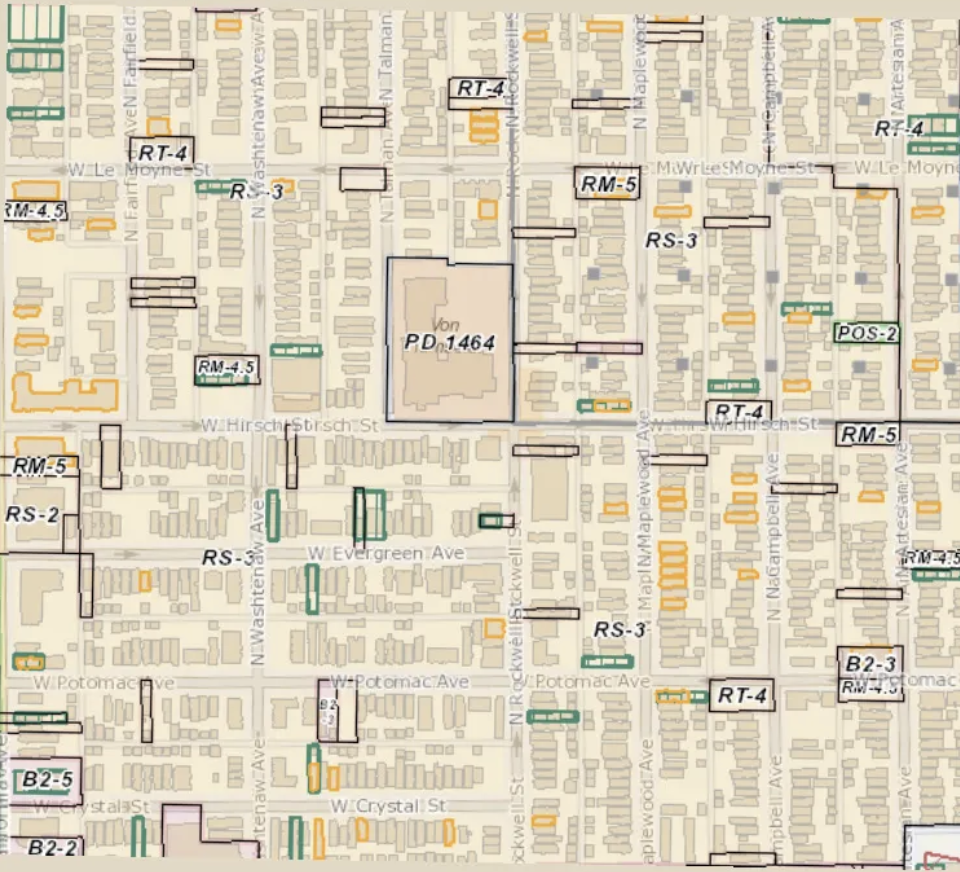
This is my neighborhood corner store. It is a block away from my house in Bucktown. I go here everyday to grab food items, basic household necessities and a few desperate times of year for a pack of cigarettes. What may surprise you is that this is the very last corner store in the entire neighborhood of Bucktown (a neighborhood of about 15,000 people) not on a major street.

If it wasn’t for this shop being a few steps from my house, I’d have to walk to Jewel, 7/11, or Polonia Mart which are about 4 blocks (aka c. 1/2 mile) from my house. Although I have a car and the ability to drive to one of these shops for quick errands, I consider it a huge plus to be to and from my house on foot in less than 5 minutes when I need a can of beans or salt or a bag of chips.
What’s always been funny to me is that at the end of nearly every residential block in the first and second ring neighborhoods outside of downtown like this one, there was one of these shops, or some other small business bookending every corner. The remnants of these businesses still remain, mainly as apartments or single family home conversions.
On the left you will see a bar that used to be at the end of my street, The Artful Dodger. On the right, what replaced it.
I’ve lived in Chicago for half of my life now. And even in these few decades I’ve seen more and more of the side street businesses slip away, many forever. I wanted to get into where our residential corner businesses are going and why under Chicago zoning code they may never return.
Chicago introduced its first real zoning code in 1923. Although it would be overhauled two more times since then, this concise (only 20 pages) document outlined the governing principles of where residential buildings should be, where commercial buildings should be, and height restrictions on each. Zoning was enacted after years of Chicagoans complaining to their local alderman about having to live next to noxious smells or sounds. Back then, when commercial and residential buildings dotted each block, a tannery or a livery or a metal worker could move into the building next to you, impacting your quality of life and your property values.
This code and the later, more robust 1957 version cemented the idea that away from the downtown core, blocks with primarily residential housing should be used for living and all businesses should be moved to the arterial streets (which are every 4 blocks in either direction based on our grid system). Obviously this change was an undue hardship on neighborhood business owners so the 1923 code also created the Zoning Board of Appeals. The ZBA allowed business owners with non-conforming land uses to petition the city for an exemption. This kept many of these existing buildings around through another generation.
The 1957 code created the lettering and numbering systems in addition to several other guidelines governing bulk and density. This code also foisted an 8 year sunset period on any non-conforming land use. This put existing businesses on R zoned lots on borrowed time. Due to the city’s poor enforcement, many of these non conforming businesses still eked by in the following years but as businesses shuttered, new licenses were not issued to businesses in buildings on residential zoned lots.
Chicago’s unprecedented population loss in the 1970s and 80s accelerated the shuttering of corner store businesses which relied heavily on neighborhood density to stay afloat. This left a sea of disused storefronts and blighted buildings now zoned for residential use around inner rings neighborhoods. It wasn’t until the 90s and 2000s when investment started to return to these areas that savvy new owners began to take advantage of the wide open spaces and lack of bearing walls of these storefronts and convert them into loftesque apartments or single family homes. Just as many were torn down.
Chicago’s zoning code in most neighborhoods is broken down to a handful of letters. R denotes solely residential use allowed, B and C allow for businesses on the first level of a building. Here is Bucktown between North Ave and Armitage between Western Ave and the Highway.

A zoning map of Bucktown, Chicago.
Despite nearly every block end containing multiple storefront buildings, only 11 active non arterial street businesses remain in this entire neighborhood. Note the prevalence of R zoning on all of these buildings making it illegal to open new businesses in these existing spaces.
Here is East Humboldt Park. Western-California, Le moyne-Crystal. Same story, 0 corner businesses remain active here.

A zoning map of East Humboldt Park, Chicago.
On the other hand here is Pilsen. Equidistant to downtown and like Bucktown and Lincoln Park, dotted with tons of mixed use buildings. Yet most still carrying B zoning. Many of the businesses that fill these buildings are still active and the buildings themselves carry the appropriate zoning for future businesses to exist there.
Zoning maps of Pilsen, Chicago.
I don’t think that with the hundreds of mixed-use buildings these neighborhoods once housed, that all of them could hold profitable businesses in every storefront today. The way neighborhoods in a city like New York are able to support all of these shops in these small mixed use buildings is due to its population density. Even low and mid rise centric areas like Greenwich Village have 79,000 residents living per square mile. At the height of West Town’s population there were nearly 40,000 people per square mile living there. There are about 18,000/sm today. Lincoln Park had 32,000/sm and now has 22,000. This loss of density is one of the main reasons most of the active businesses in these buildings shuttered in the first place so seeing them return and having a zoning code to reflect their viability is very unlikely.
I think it’s important in areas with tons of housing demand that these storefronts be retrofitted as living space and not torn down. In addition to giving the streetscape the historic charm everyone loves so much in Chicago, most of these buildings usually far exceed the buildable square footage allotment that their current zoning code allows for. The way in which old storefronts were built also allows for some really incredible retrofits whether it be to single family houses or apartments. I have sold my fair share of former mixed use buildings and I even own a building that has a storefront-residential conversion!

One of the biggest differences in urban planning in the 20th vs 21st century is the importance placed on the pedestrian experience over driver accessibility. Clunky and austere mid-century planning that favored big buildings with big setbacks and huge parking allotments have fallen by the wayside. Although the markets still favor larger, economy of scale buildings, what’s prevailed recently are high-density multi-family buildings integrated into their neighborhood surroundings with low resident/parking ratios. We even have zoning amendments now where parking requirements can be waived entirely!
The next and most obvious step to me in this new planning wave would not just be hyper dense arterial streets tapering off into pure residential blocks but the implementation of more walkable businesses located within these still dense inner-ring neighborhoods. Allowing old mixed use buildings more flexible zoning that allows business, live/work or living space (B2) could help allow the market to decide whether spaces are better suited to living or business. I think corner mixed-use buildings that have had businesses hold out this long should be able to remain mixed use even if the business has shuttered and not decided by a zoning code forced on generations after it was built. Is this likely to happen?

Charlie Cohen is a Senior Broker and Sales Leader at Cross Street.
Throughout 10 years in Real Estate and as a Senior Broker at Cross Street, Charlie has closed hundreds of deals from apartment leases to sales of multimillion dollar homes and apartment buildings, cafes, industrial space and everything in between. Charlie uses his network and background in investment property acquisition, management and construction to apply an analytical approach to home buying, from helping clients understand the importance of different period aesthetics and build quality to financial analysis and specifically tailored borrowing options.
Join our mailing list to receive notifications every time a new blog post is live.